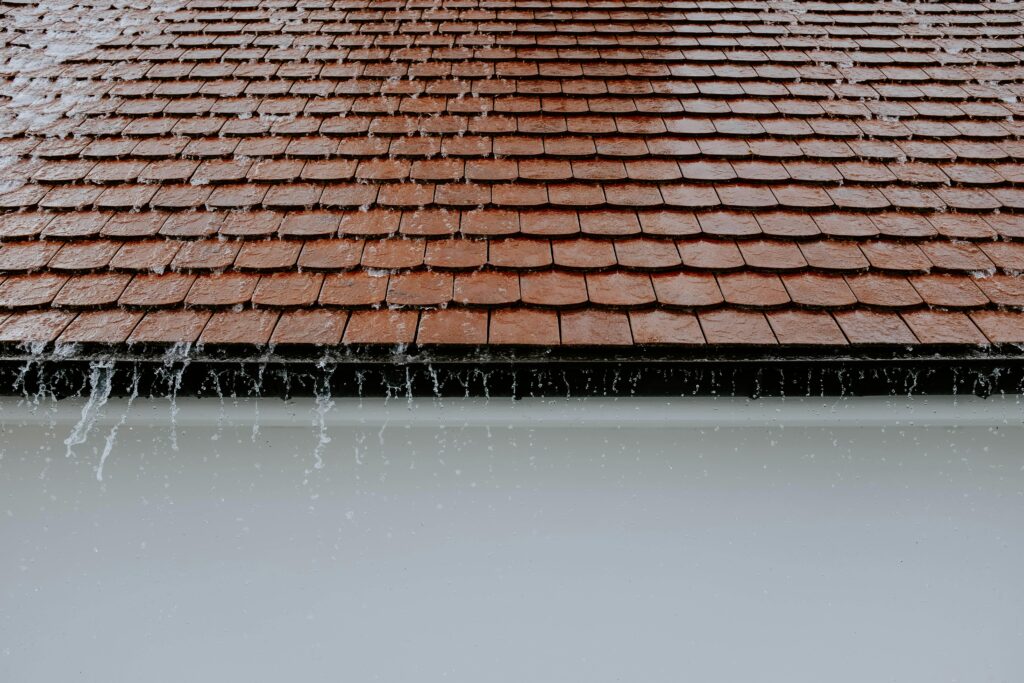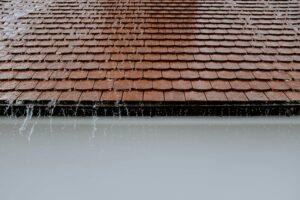Table of Contents
Start with a Thorough Inspection
Clear Out the Culprits: Clean Your Gutters
Secure the Supports: Tighten or Replace Brackets
Bolster the System: Add More Supports
Ensure Proper Flow: Check Gutter Alignment (Slope)
Living in Highland, Maryland, we experience a range of weather conditions that put our homes’ exteriors to the test. One common issue homeowners face, often noticed after a heavy rain or strong winds, is sagging gutters. It might seem like a minor cosmetic problem, but at Columbia Roofing, we know that untreated sagging gutters can lead to significant headaches down the road. Water damage to your roofline, fascia boards, soffits, landscaping erosion, and even foundation problems can stem from gutters that aren’t doing their job correctly. Plus, let’s face it, sagging gutters detract from your home’s curb appeal.
Fixing this issue promptly is key to maintaining your property’s structural integrity and avoiding costly future repairs. While some fixes can be tackled by homeowners, knowing how to address the problem is crucial. If you’re unsure or the job seems too complex, our experienced roofing and gutter technicians at Columbia Roofing are always ready to help residents in the Columbia, Maryland area with professional repair and replacement services.
Here’s a breakdown of how you might address sagging gutters:
1. Start with a Thorough Inspection
Before you can implement a fix, you need to understand the cause. Put on some sturdy gloves and, if you can do so safely, climb a secure ladder to get a close look at your gutter system.
- Look for Loose or Damaged Brackets: Are the hangers or brackets holding the gutter loose? Are they bent, broken, or rusted?
- Check the Fasteners: Are the screws or nails backing out of the fascia board (the board the gutter attaches to)? Are they rusted through?
- Identify Points of Separation: Note exactly where the gutter is pulling away from the fascia.
- Find the Root Cause: Don’t stop inspecting until you’ve pinpointed why the gutter is sagging. Is it blockage weight? Failing hardware? Rotted fascia board? Determining the underlying issue is essential for choosing the right solution.

2. Clear Out the Culprits: Clean Your Gutters
Often, the simplest reason for sagging is accumulated weight. Leaves, twigs, shingle grit, pine needles, and dirt can build up, especially after storms or during the fall. This heavy, often water-logged debris puts immense strain on the gutter sections and their supports.
- Remove Debris: Using a gutter scoop or trowel and wearing protective gloves, carefully remove all debris from the sagging sections and surrounding areas.
- Flush the System: Once the bulk of the debris is gone, use a garden hose to flush the gutters and downspouts. This helps clear out smaller particles and allows you to check if water is flowing correctly towards the downspouts. A clean gutter is less likely to sag and overflow.
3. Secure the Supports: Tighten or Replace Brackets
The brackets (or hangers) are the unsung heroes holding your gutters in place. Over time, due to weight, weather, or thermal expansion/contraction, they can loosen or fail.
- Check Every Bracket: Examine all the brackets along the affected gutter run, not just the ones at the lowest point of the sag.
- Tighten Loose Fasteners: If screws or nails are simply loose, try tightening them securely into the fascia board. If the hole is stripped, you might need a slightly larger screw or to relocate the bracket slightly.
- Replace Damaged Hardware: If brackets are bent, broken, rusted, or otherwise compromised, they need to be replaced. Unscrew or pry out the old bracket and install a new one, ensuring it’s firmly secured to the fascia. Properly functioning brackets are vital for adequate support.
4. Bolster the System: Add More Supports
Sometimes, the original gutter installation didn’t include enough support brackets for the length or pitch of the roof. The spans between hangers might be too wide, allowing the gutter to sag under normal weight, especially when full of water.
- Assess Spacing: Check the distance between existing brackets. While standards vary, if they seem excessively far apart (e.g., more than 3 feet), adding more support is wise.
- Install Additional Brackets/Hangers: Purchase compatible gutter hangers and install them between the existing ones. Aim for even spacing to distribute the weight uniformly and prevent future sagging. Ensure these new supports are also securely fastened.

5. Ensure Proper Flow: Check Gutter Alignment (Slope)
Gutters need a slight, almost imperceptible slope towards the downspouts to function correctly. If a gutter section is level, back-pitched (sloping away from the downspout), or has developed a low spot due to sagging, water can pool. This standing water adds weight, encourages debris buildup, and increases stress on the system.
- Use a Level: Place a carpenter’s level inside the gutter (once clean). Check the slope along the entire length.
- Adjust as Needed: If the slope is incorrect, you may need to adjust the position of the brackets. This might involve slightly raising or lowering hangers to encourage water to flow downhill towards the nearest downspout. Proper alignment is critical for efficient water drainage and reducing sag risk.
When DIY Isn’t Enough: Call Columbia Roofing
While these steps can address many common causes of sagging gutters, some situations require professional expertise:
- Safety Concerns: If you’re uncomfortable working on a ladder or dealing with heights, leave it to the pros.
- Extensive Damage: If the fascia board itself is rotted or damaged, it will need repair or replacement before new gutters or brackets can be securely attached.
- Complex Alignment Issues: Achieving the correct slope over long runs can be tricky.
- Persistent Problems: If you’ve tried fixes and the sagging continues, there might be a more significant underlying issue.
- Considering Replacement: If your gutters are old, severely damaged, or constantly problematic, replacement might be more cost-effective than ongoing repairs.
Protect Your Investment – Address Sagging Gutters Today
Taking care of sagging gutters isn’t just about appearances; it’s about protecting your Columbia home from preventable water damage and expensive repairs. By performing regular inspections and addressing issues promptly, you can extend the life of your gutter system and safeguard your property. If you’ve noticed sagging gutters, aren’t sure how to proceed, or want a professional inspection and assessment, don’t hesitate to reach out to the local experts at Columbia Roofing. We proudly serve homeowners throughout Columbia, Maryland, and surrounding areas.
Contact Columbia Roofing in Howard County Maryland today for reliable gutter repair, replacement, and inspection services! Call us at: 410-379-6100 Visit our website: https://columbiaroofing.com Trust your local experts at Columbia Roofing to keep your home safe and dry!






